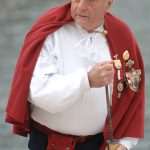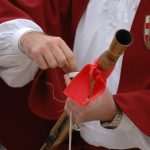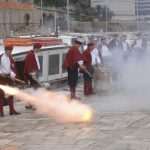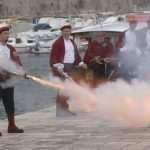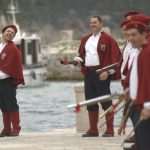The feast day of Saint Blaise would not be what it is without the Dubrovnik Trombunjeri . Wearing distinctive suits and carrying short, broad “guns” on their shoulders – the trombunjer whose gunshot warns of a significant happening in the City of Dubrovnik, is an intrinsic part of the celebrations on February 3rd each year.
Since 1987, Mr. Antun Knego has been president of the Dubrovnik Trombunjeri and a member of the society since its re-establishment in 1970, ”Trombunjeri are referred to in documents dating back as early as 1417. They were abolished in 1946 up until the 1000th feast day of Saint Blaise when there were neither elected masters of ceremony (Festanjuli). So, in 1969 we re-established the Dubrovnik Trombunjeri for the 1000th feast day.” Antun follows in his father’s footsteps who was too a trombunjer, his sons Pero and Frano will continue the family tradition.
”You can not be something if you do not like it, if it’s not in you and you are not in love with it . As my late father was a trombunjer and played music in Komolac before the war, I too became involved. I wore the banner of the Holy Spirit from Komolac , I was even the best flag bearer . Anyone who likes trombunjeri is with us . My sons are delighted that they are involved because anyone who loves trombunjeri is in our society.”Knego said in answer to what it takes to be a trombunjer.
Of course, the Feast of St. Blaise is something special says Knego adding, ” The Feast of St. Blaise is not a festivity without trombunjeri, it is the feast day of trombunjeri . During the time of the Dubrovnik Republic, on the feast day of St. Blaise, a display of weapons was held and all men capable of carrying weapons had come to the Festa in order for the Rector to see what was available and with which the city could be defended.”
The Dubrovnik Trombunjeri now has 55 members and in particular has a great interest from young people according to Knego, ”We are pleased with the number of members, but we are missing uniforms and trombunes. Young people are interested in joining in our society and it’s good to be rejuvenated. Everyone has their own trombun which cost about 1000 Euros, and many would like us to loan them a trombun but we unfortunately don’t have them.”



